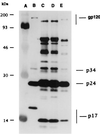Simian immunodeficiency virus replicates to high levels in naturally infected African green monkeys without inducing immunologic or neurologic disease
- PMID: 11160730
- PMCID: PMC114810
- DOI: 10.1128/JVI.75.5.2262-2275.2001
Simian immunodeficiency virus replicates to high levels in naturally infected African green monkeys without inducing immunologic or neurologic disease
Abstract
African green monkeys can maintain long-term persistent infection with simian immunodeficiency viruses (SIVagm) without developing AIDS and thus provide an important model for understanding mechanisms of natural host resistance to disease. This study assessed the levels and anatomic distribution of SIVagm in healthy, naturally infected monkeys. Quantitative competitive reverse transcriptase PCR assays developed to measure SIVagm from two African green monkey subspecies demonstrated high levels of SIV RNA in plasma (>6 x 10(6) RNA copies/ml) in sabaeus and vervet monkeys. Infectious virus was readily recovered from plasma and peripheral blood mononuclear cells and shown to be highly cytopathic in human cell lines and macrophages. SIVagm DNA levels were highest in the gastrointestinal tract, suggesting that the gut is a major site for SIVagm replication in vivo. Appreciable levels of virus were also found within the brain parenchyma and the cerebrospinal fluid (CSF), with lower levels detected in peripheral blood cells and lymph nodes. Virus isolates from the CSF and brain parenchyma readily infected macrophages in culture, whereas lymph node isolates were more restricted to growth in human T-cell lines. Comparison of env V2-C4 sequences showed extensive amino acid diversity between SIVagm recovered from the central nervous system and that recovered from lymphoid tissues. Homology between brain and CSF viruses, macrophage tropism, and active replication suggest compartmentalization in the central nervous system without associated neuropathology in naturally infected monkeys. These studies provide evidence that the nonpathogenic nature of SIVagm in the natural host can be attributed neither to more effective host control over viral replication nor to differences in the tissue and cell tropism from those for human immunodeficiency virus type 1-infected humans or SIV-infected macaques.
Figures





References
-
- Allan J S. Receptor-mediated activation of the viral envelope and viral entry. AIDS. 1993;7(Suppl. 1):S43–S50. - PubMed
-
- Allan J S, Kanda P, Kennedy R C, Cobb E K, Anthony M, Eichberg J W. Isolation and characterization of simian immunodeficiency viruses from two subspecies of African green monkeys. AIDS Res Hum Retrovir. 1990;6:275–285. - PubMed
-
- Allan J S, Strauss J, Buck D W. Enhancement of SIV infection with soluble receptor molecules. Science. 1990;247:1084–1088. - PubMed
-
- Bagasra O, Steiner R M, Ballas S K, Castro O, Dornadula G, Embury S, Jungkind D, Bobroski L, Kutlar A, Burchott S. Viral burden and disease progression in HIV-1-infected patients with sickle cell anemia. Am J Hematol. 1998;59:199–207. - PubMed
Publication types
MeSH terms
Substances
Grants and funding
LinkOut - more resources
Full Text Sources
Molecular Biology Databases
Miscellaneous

